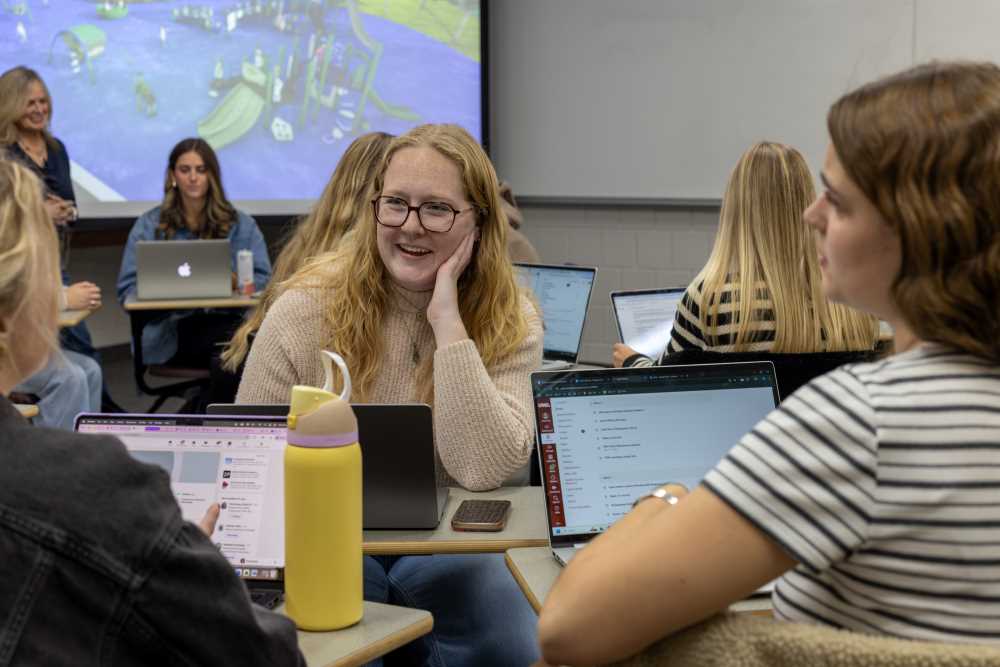Posted 1:57 p.m. Tuesday, Nov. 25, 2025

Students support community projects through grant writing course
When students in ENG 314: Grant Writing step into the classroom, they are not just learning to write — they are learning how to make a tangible impact.
This fall, Associate Professor of English Louise Zamparutti partnered her class with the Trempealeau Parkland Development Project (TPP), giving UW-La Crosse students the opportunity to apply their writing skills to a real-world cause: helping a local town build accessible, inclusive recreational spaces for people of all ages.
Zamparutti’s class is part of UWL’s Community Engaged Learning (CEL) Program, now in its fifth year of expanding community-based learning opportunities on campus. Thanks to a recent $100,000 gift from Advisors Management Group (AMG), CEL-designated classes receive funding for instructor development and course materials, allowing faculty to deepen partnerships and give students meaningful, resume-ready experiences.
Students in Zamparutti’s class worked alongside Nancy Brown, lead organizer of the TPP, to craft professional grant proposals to secure funding for features like accessible playground equipment, walking trails and adaptable sports fields.
Zamparutti says the collaboration was a natural fit.
“Lisa Klein (director of Community Engagement) contacted me towards the end of the spring semester about the possibility of collaborating with the TPP in the fall,” Zamparutti says. “As I learned more about the project, I was drawn to it for several reasons. First, there is an obvious need. Trempealeau and the surrounding towns are currently maxed out on recreation areas and sports fields, with many different teams and leagues in the area and very limited resources.”

Beyond addressing that need, the project embodies the kind of community partnership Zamparutti wants her students to understand.
“It’s a great example of how nonprofits work in partnership with other organizations and secure funding through a variety of sources,” Zamparutti explains. “This project really illustrates the value of community collaboration; it’s a great example of why social capital is important.”
Throughout the semester, students like public administration major Lacy Holmes learned to approach writing as both an art and a professional tool.
“This class emphasizes writing as a professional skill,” Holmes says. “Through client needs assessments, grant searches and meetings with nonprofit organizations, I have seen the value of grant writing firsthand. Projects such as the Trempealeau Parkland Project, The Good Fight and others demonstrate how writing can support meaningful missions and community initiatives.”
Holmes, who balances being a full-time mom, a full-time homeownership empowerment manager and a volunteer at a local middle school, says working with the TPP gave her insight into how small communities balance growth and preservation.
“Trempealeau is a small, tight-knit community that is organized and committed to maintaining its values,” Holmes explains. “Like many communities, Trempealeau faces the challenge of balancing responsible growth with preserving its identity.”
Holmes was particularly inspired by how the Village of Trempealeau and the Trempealeau Youth Sports Committee worked together to secure funding.
“The Village has already committed $3 million of the $6 million needed,” Holmes says. “The project includes a sustainability plan that reduces reliance on yearly grant searches. Meeting with the La Crosse Area Community Foundation highlighted how local nonprofits benefit from support in grant applications to sustain operations.”
The class visit to the project site left a lasting impression on Holmes.
“Seeing the progress in person brought the project to life and gave me a deeper appreciation for its impact,” Holmes says. “It was incredible to see how something we were writing about was already taking shape before our eyes.”
For Zamparutti, those moments of connection are central to the course’s purpose.
“Students are learning how to present community needs both in terms of hard data —people and resources in numbers, demographics, etc. — and in terms of stories: whose lives would be impacted positively by this project,” Zamparutti says. “They learn how to frame community needs as opportunities for positive impacts by showing numbers, identifying gaps and telling compelling stories.”
Projects like the one undertaken by Zamparutti’s class demonstrate how UWL’s CEL initiative bridges classroom learning with community transformation.
“This course has already changed the way I think about social service programs and the effort required to sustain them. It has given me greater insight into my own role at a local nonprofit and how grant writing directly affects my work," Holmes says. “Looking ahead, I believe these skills will continue to strengthen my critical thinking, whether I pursue a career in public administration or nonprofit work.”
Through their words, UWL students are not just writing for change — they are helping to build it.
Learn more about the Community Engaged Learning program.
Across campus, other CASSH courses are turning learning into action to support the community. In ENG 387: Environmental Literature, students led an interactive art walk at the Minnesota Marine Art Museum, exploring the question “Is Water Alive?” Students in HIS 393: Material Culture are helping the museum confront “problematic” objects in its collection. Students in SOC 323: Corrections and Penology are working with incarcerated fathers at the New Lisbon Correctional Institution to record audiobooks for their children. Finally, students in ENV 496: Environmental Studies Capstone are taking action through local environmental service learning projects. Together, these courses show how UWL is transforming classrooms into catalysts for community impact.
